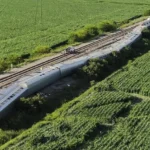Country Drivers, Silent Conductors, and a Free Lunch.
Is it just me? Or do country folks approach grade crossings with a lot more caution than people in cities? During my recent Amtrak trip—on the Lake Shore Limited and the California Zephyr—I became aware that drivers in rural areas seemed to be stopping 80 or 100 feet from the barrier and the flashing lights at grade crossings. City folks, on the other hand, pull right up to the barrier before they stop. I wonder why that is? And I wonder if anyone else has noticed it.
I was also reminded that many Amtrak conductors are really remiss when it comes to keeping passengers informed as to what’s going on. I’ve heard it said—admittedly with no official confirmation—that the most commonly asked question aboard an Amtrak train is, ”Why are we stopped?”
Whether that’s true or not, it does focus on a big source of irritation among rail passengers, particularly those of us who know a bit more about rail travel than the average person.
Which is better?
1- To be sitting on a train stopped in the middle of nowhere for a half hour and have no idea why.
2- The conductor announces that we’re on a siding ten miles east of the South Bend station waiting for a freight train which should be here in another five minutes.
Right. Door Number Two. How hard can it be??
Finally, all these delays because of freight traffic are costing Amtrak millions. My recent trip included the Lake Shore Limited, which is scheduled to arrive in Chicago at 9:45 in the morning. Because of numerous problems caused by bitter cold weather, the train on that particular day ran some eleven hours late. But to my great surprise, lunch was served in the dining car! I was delighted, of course, but in addition to all the costs associated with a lot of missed connections, that food for 40 or 50 people was not covered in the fares. Do you think something like that is taken into consideration by the ghouls in Congress who are demanding that Amtrak break even on food service? Of course not.



